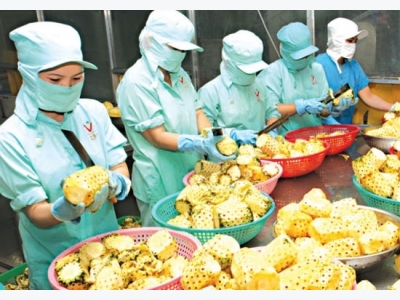Four-month export highlights

In the first four months of this year, Vietnam’s export value grew 15.4 percent compared with the same period in 2016, much higher than projected.
Fruit and vegetables were bright points in the export picture of the first four months of 2017
Telephone exports
According to the general Statistics office of Vietnam, the export value reached an estimated US$16.7 billion in april and US$61.3 billion in the first four months, a rise of 15.4 percent compared with the same period last year.
Telephones contributed significantly to export growth in this period. Export of telephones and components reached an estimated US$3.6 billion in april, up 17.4 percent compared with March, and more than US$11.37 billion in the first four months, up 0.3 percent compared with the same period last year.
These were encouraging results because data from the general Statistics office of Vietnam show that in the first three months of this year, export value of these products decreased 10.7 percent compared with the same period
in 2016. That drop was the result of the Samsung galaxy note 7 flaw that led to a decline of US$888 million in export value. Due to an apparent recovery in April, telephones and components maintained second place on the export value list in the first four months, behind textiles and garments.
The export value of telephones and components is predicted to continue growing, based on the orders received by Samsung for its newly launched galaxy S8 and galaxy S8 Plus phones. Experts’ analyses show that once this product line sells well in the world market, Samsung Vietnam’s exports will also increase and have a positive impact on Vietnam’s export value.
In the context of increasing use of electronic devices worldwide, telephones and components are forecast to usurp the number-one position of textiles and garments on the export list in the future. Made-in-Vietnam telephones have been exported to many countries, including discerning markets such as the 28 EU member countries, the US, the United Arab Emirates and Asean.
Agricultural export highlights
The early months of this year saw steady increases in the export of some agricultural products. While pork prices plunged, the export of major farm products such as timber and wood, seafood, coffee, and especially fruit and vegetables grew steadily.
Specifically, the export value of fruit and vegetables reached an estimated US$313 million in april and US$1 billion in the first four months, a rise of 32.6 percent compared with the same period last year. China, the US, Japan and South Korea remain the top four importers of Vietnamese fruit and vegetables, accounting for 82.9 percent of the export value of these products.
Strong increases in the export value of fruit and vegetables have brought about higher domestic prices of these products. In april, Java rambutans were exported from Ben Tre and Vinh Long provinces at prices ranging from VND55,000 to VND60,000 per kg, up about VND20,000 compared with the same time in 2016, while the export price of higher-quality rambutans ranged from VND70,000 to VND80,000 per kg, up VND10,000-VND15,000 compared with February.
Prices of pineapples grown in Tien Giang Province have increased after continuous drops. Currently, traders buy pineapples at prices around VND4,500 per kg depending on quality, an increase of nearly VND2,000 compared with the lowest price in the recent period. Selling at these prices, farmers can earn a profit of about VND500 per kg. Increased prices make farmers feel secure about their investments in intensive farming to achieve higher economic effectiveness.
Wood product exports have also increased after making almost no progress in 2016. Since the beginning of this year, the export value of the wood sector has grown more than 17 percent – a necessary development for the sector to raise its export value to US$10 billion by 2020 as planned.
Experts forecast that 2017 will provide new opportunities for the Vietnamese wood sector because the US has imposed anti-dumping taxes on Chinese wood products. China holds a 37 percent market share of wood products imported by the US and is Vietnam’s major rival in this market (the US imports about US$30 billion worth of wood products annually).
Due to these anti-dumping taxes, US importers will possibly turn their attention to wood exporters in Asean, creating potential for Vietnam to boost wood exports to the US, especially furniture.
In the context of global economic problems leading to a decline in the export value of major products such as textiles, garments, rice, cassava and pepper, steady increases in the export value of agricultural products in the early months of this year were encouraging. These products are expected to further contribute to Vietnam’s export value towards year’s end, helping reduce the trade deficit and increase foreign currency reserves for the country.
Related news
 New technology extracts drinking water and crop fertiliser from air
New technology extracts drinking water and crop fertiliser from air Seven new projects are being supported by J-WAFS this year, and two notable initiatives include harvesting water from air – developing technology
 Branding agribusiness commodities for adding value
Branding agribusiness commodities for adding value Due to solid economic growth over the past decade and the expanding Vietnamese middle income class the demand for a wider variety and higher quality
 Vietnam rice export back on track
Vietnam rice export back on track Vietnam’s rice export growth has regained momentum this year after a year of slowdown, according to a report by the Vietnam Food Association (VFA).